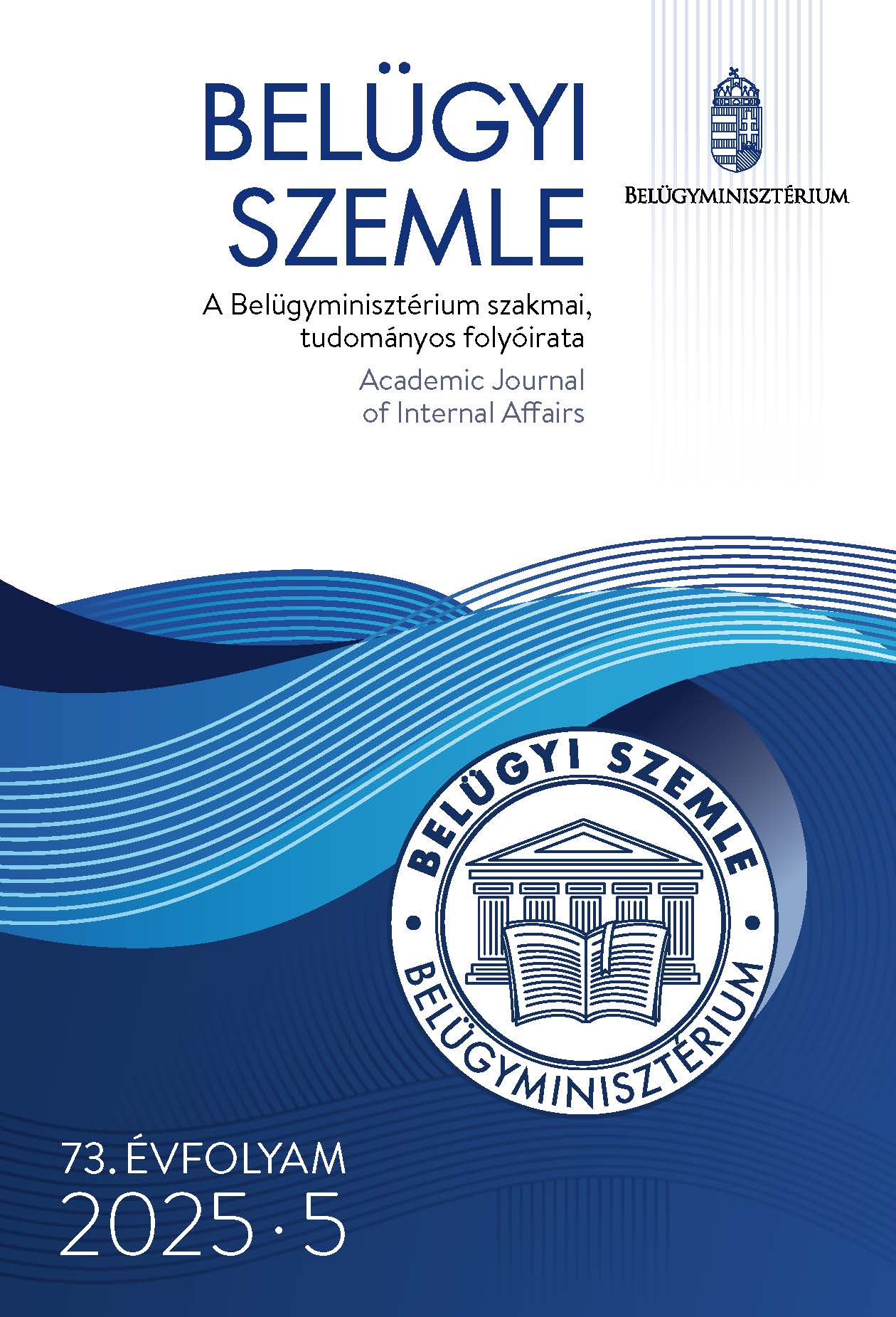Abstract
Aim: The aim of the study is to raise awareness of the links between the development of biometric identification and artificial intelligence (AI) and to present the methods developed for risk assessment of biometric identification solutions.
Methodology: The authors have reviewed a wide range of Hungarian and foreign literature, academic works and legislation on the theoretical methods and context. In doing so, the methods of analysis and synthesis were applied, the subject areas were broken down into their constituent parts and studied in depth separately, thus enabling the parts to be identified. In the course of the analyses, the separate parts and areas were reorganised and integrated into a logical whole. In doing so, the interlinkages were examined and it was concluded that the uptake of biometrics is not primarily an identification technology issue, but an IT methodological issue for processing biometric data and the associated data management and security risks. In their research, induction, deduction and analogy play an important role, as they have broken down the problems into parts, analysed them and drawn conclusions, going deeper and deeper as they move from the known to the unknown.
Findings: AI regulation is interlinked with biometric identification in multiple ways, and national and EU legislators are striving to create a regulatory environment of trust and confidence across the entire value chain, which can lead to a high level of trust and reduce the risks of biometric identification solutions.
Value: The authors have explored the context of biometric identification, the legal background to the processing of personal data and the relationship with AI, and have highlighted the risks associated with it. They developed a specific framework for risk assessment of biometric identification solutions.
References
Ahmad, Z., Ajmal, M., Ahmad, F., Chaudary, M. H., & Naseer, M. (2018). Comparative analysis of biometric recognition techniques. Bahria University Journal of Information and Communication Technologies, 11(1), 21–30.
Balla J. (2019). A biometrikus adatokat tartalmazó úti és személyazonosító okmányok biztonságnövelő hatása a határ-, illetve közbiztonság alakulására. Dialóg Campus Kiadó.
Crisan, S. (2016). A novel perspective on hand vein patterns for biometric recognition: Problems, challenges, and implementations. In R. Jiang, S. Al-Maadeed, A. Bouridane, & P. Crookes (Eds.), Biometric security and privacy: Opportunities & challenges in the Big Data era (pp. 21–49). Springer. https://doi.org/10.1007/978-3-319-47301-7_2
Jain, A. K., Ross, A. A., & Nandakumar, K. (2011). Introduction to Biometrics. Springer. https://doi.org/10.1007/978-0-387-77326-1
Karimi, Z., Najafabadi, S. A., Nezhad, A. R., & Ahmadi, F. (2022). A big survey on biometrics for human identification. In T. Saba, A. Rehman, & S. Roy (Eds.), Prognostic models in healthcare: AI and statistical approaches (pp. 305–325). Springer. https://doi.org/10.1007/978-981-19-2057-8_14
Markowitz, J. (2000). Voice biometric. Communications of the ACM, 43(9), pp. 66–73. https://doi.org/10.1145/348941.348995
Őszi A. (2019). A biometrikus azonosítási rendszerek helye és szerepe az e-kereskedelemben (PhD-értekezés). Óbudai Egyetem. http://dx.doi.org/10.13140/RG.2.2.12200.14088
Őszi, A., & Kovács, T. (2011). Theory of the biometric-based technology in the field of e-commerce. In Proceedings of the 12th IEEE International Symposium on Computational Intelligence and Informatics (CINTI 2011). Óbuda University. https://doi.org/10.1109/CINTI.2011.6108570
Peña, A., Morales, A., Serna, I., Fierrez, J., & Lapedriza, A. (2021). Facial expressions as a vulnerability in face recognition. In 2021 IEEE International Conference on Image Processing (ICIP) (pp. 2988–2992). IEEE. https://doi.org/10.1109/ICIP42928.2021.9506444
Ratha, N. K., Connell, J. H., & Bolle, R. M. (2001). An analysis of minutiae matching strength. In J. Bigün & F. Smeraldi (Eds.), Audio- and video-based biometric person authentication (pp. 223–228). Springer. https://doi.org/10.1007/3-540-45344-X_32
Srivastava, H. (2013). A comparison based study on biometrics for human recognition. IOSR Journal of Computer Engineering, 15(1), 22–29. https://doi.org/10.9790/0661-1512229
Sunil, S. H., Prashanth, C. R., & Raja, K. B. (2019). Comprehensive study of biometric authentication systems, challenges and future trends. International Journal of Advanced Networking and Applications, 10(4), 3958–3968. https://doi.org/10.35444/IJANA.2019.10048
Tripathi, K. P. (2011). A comparative study of biometric technologies with reference to human interface. International Journal of Computer Applications, 14(5), 10–15. https://doi.org/10.5120/1842-2493
Wendehorst, C., & Duller, Y. (2021). Biometric recognition and behavioural detection (European Parliament Study No. 696968). European Parliament. https://www.europarl.europa.eu/RegData/etudes/STUD/2021/696968/IPOL_STU(2021)696968_EN.pdf
Yan, Z., Lv, S., Zhang, Y., Zhu, H., & Sun, L. (2019). Remote fingerprinting on internet-wide printers based on neural network. In 2019 IEEE Global Communications Conference (GLOBECOM) (pp. 1–6). IEEE. https://doi.org/10.1109/GLOBECOM38437.2019.9014144
Zhang, D., & Lu, G. (2013). 3D biometrics: Systems and applications. Springer. https://doi.org/10.1007/978-1-4614-7400-5

This work is licensed under a Creative Commons Attribution-NonCommercial-NoDerivatives 4.0 International License.
Copyright (c) 2025 Academic Journal of Internal Affairs

